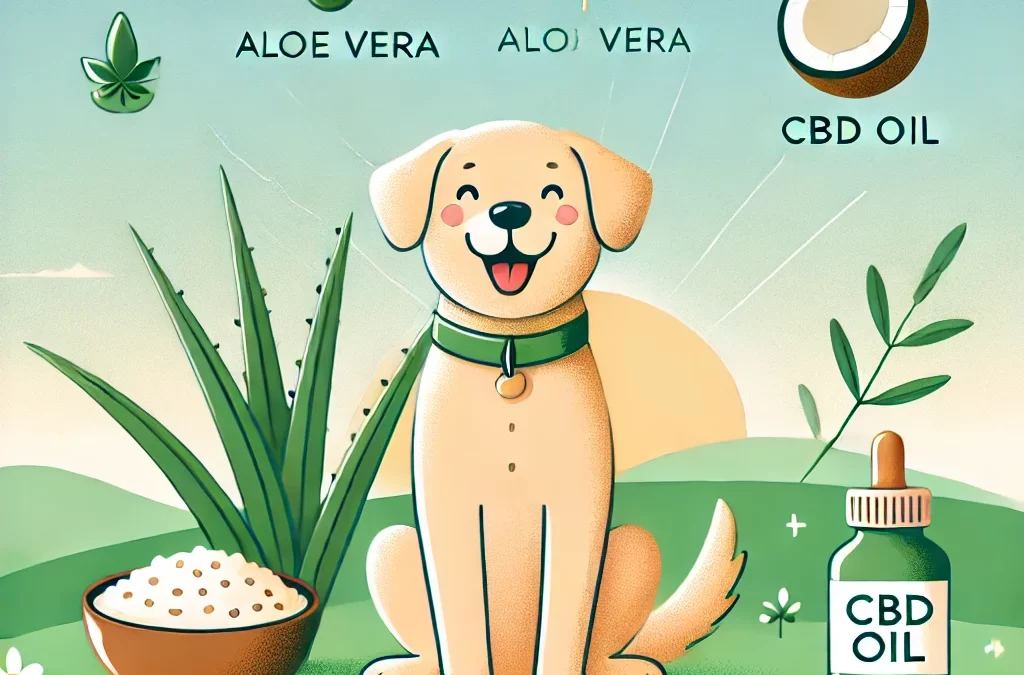
utworzone przez TCMVET | paź 25, 2024 | Chińska medycyna ziołowa dla zwierząt domowych
Chuanxiong, znany również jako lubczyk syczuański, jest cennym ziołem w tradycyjnej medycynie chińskiej, znanym ze swojej zdolności do pobudzania krążenia krwi i usuwania zastoju krwi. W ostatnich latach zyskał uwagę ze względu na swoje potencjalne korzyści w pomaganiu psom z objawami zastoju krwi spowodowanymi przez guzy.
Jak Chuanxiong pomaga psom z guzami
- Poprawia krążenie krwi
Chuanxiong jest bardzo skuteczny w promowaniu przepływu krwi. U psów cierpiących na guzy może pomóc poprawić krążenie, zapewniając, że tlen i składniki odżywcze dotrą do obszarów ciała, w których krążenie może być upośledzone.
- Rozwiązuje problem zastoju krwi
Guzy często mogą prowadzić do zastoju krwi, stanu, w którym przepływ krwi jest powolny lub zablokowany. Chuanxiong pomaga, rozbijając te blokady, promując płynniejszy przepływ krwi i pomagając organizmowi wydajniej usuwać toksyny.
- Łagodzi ciśnienie guza
W miarę jak guzy rosną, mogą powodować uczucie ucisku lub dyskomfortu w dotkniętych obszarach. Chuanxiong łagodzi te objawy poprzez poprawę krążenia krwi i zmniejszenie rozmiaru zastoju krwi wokół guza, łagodząc w ten sposób dyskomfort.
- Łagodzi ból
Wiadomo, że Chuanxiong ma właściwości łagodzące ból. Dla psów z guzami ból może być poważnym problemem. Zioło to może pomóc zmniejszyć ból, zajmując się przyczyną źródłową, taką jak słabe krążenie lub stan zapalny, zapewniając naturalną ulgę.
- Wspiera naturalne leczenie
Poprawiając przepływ krwi i zmniejszając zastoje, Chuanxiong wspomaga naturalne mechanizmy lecznicze organizmu, co czyni go doskonałym suplementem, który można włączyć do holistycznego planu leczenia raka u psa.
Jak włączyć Chuanxiong do opieki nad psem
Chuanxiong można podawać w postaci suplementów specjalnie zaprojektowanych dla psów. Ważne jest, aby skonsultować się z weterynarzem, najlepiej doświadczonym w tradycyjnej medycynie chińskiej, przed wprowadzeniem jakiegokolwiek nowego zioła do diety psa. Może on doradzić Ci w kwestii właściwego dawkowania i upewnić się, że Chuanxiong jest odpowiedni dla konkretnego stanu Twojego psa.
Chuanxiong (lubczyk syczuański) to doskonały naturalny środek dla psów cierpiących na skutki guzów. Poprawiając krążenie krwi, łagodząc ciśnienie i łagodząc ból, zapewnia holistyczne podejście do wspierania ich dobrego samopoczucia. Włączenie tego zioła do rutyny zdrowotnej Twojego psa, obok opieki weterynaryjnej, może zapewnić Twojemu pupilowi bardziej komfortowe i zrównoważone życie.

utworzone przez TCMVET | paź 23, 2024 | Rak i guzy u psów
Hemangiopericytoma to złośliwy nowotwór rozwijający się z komórek perycytowych, które znajdują się wokół małych naczyń krwionośnych (naczyń włosowatych) u psów. Chociaż ten typ nowotworu może wystąpić u psów dowolnej rasy, częściej występuje u dużych ras. Wczesne wykrycie i leczenie są kluczowe dla zapobiegania dalszym powikłaniom zdrowotnym. W tym artykule podkreślono znaczenie rozpoznawania wczesnych objawów i zbadano różne dostępne opcje leczenia hemangiopericytoma u psów.
Co powoduje hemangiopericytomę u psów?
Perycyty to komórki tkanki łącznej otaczające naczynia krwionośne, odgrywające kluczową rolę we wspieraniu układu naczyniowego. W normalnych okolicznościach komórki te mogą różnicować się w inne typy komórek tkankowych, pomagając w regeneracji i naprawie. Jednak gdy dochodzi do nieprawidłowego podziału komórek, może rozwinąć się guz, taki jak hemangiopericytoma. Dokładna przyczyna pozostaje nieznana, ale czynniki takie jak genetyka, narażenie na środowisko lub uraz mogą przyczyniać się do powstawania guza.
Objawy i sygnały ostrzegawcze
Hemangiopericytomy to wolno rosnące guzy, które zwykle rozwijają się w tkance podskórnej. Chociaż guz może być początkowo niezauważalny, w miarę wzrostu może powodować dyskomfort fizyczny lub widoczne zmiany. Typowe objawy obejmują:
- Twardy guz lub masa pod skórą
- Obrzęk lub ból zlokalizowany wokół guza
- Letarg lub zmniejszona aktywność fizyczna, zwłaszcza jeśli guz wpływa na ruch
- Objawy dyskomfortu, jeśli guz naciska na ważne narządy lub stawy
- Trudności w oddychaniu, jeśli guz rozwija się w okolicy klatki piersiowej
Chociaż guz jest najczęściej zlokalizowany, w rzadkich przypadkach może dawać przerzuty do innych części ciała, szczególnie do płuc lub wątroby.
Diagnozowanie hemangiopericytoma
Jeśli u Twojego psa pojawi się guz lub pojawią się objawy, które mogą wskazywać na guz, konieczna jest wizyta u weterynarza. Dokładne badanie fizykalne, a następnie biopsja masy, to zazwyczaj pierwszy krok w diagnozowaniu hemangiopericytoma. Zaawansowane techniki obrazowania, takie jak tomografia komputerowa lub rezonans magnetyczny, mogą być również stosowane w celu oceny wielkości i lokalizacji guza, a także w celu sprawdzenia możliwych przerzutów.
Opcje leczenia hemangiopericytoma
Głównym leczeniem hemangiopericytoma jest chirurgiczne usunięcie guza. Ponieważ guzy te mogą być głęboko osadzone w tkance, operacja może wymagać rozległego zabiegu, aby zapewnić całkowite usunięcie i zmniejszyć ryzyko nawrotu. W przypadkach, gdy guza nie można całkowicie wyciąć lub jeśli znajduje się on w wrażliwym miejscu, takim jak klatka piersiowa, można zastosować radioterapię w celu zmniejszenia guza przed operacją.
Chemioterapia jest inną opcją, szczególnie jeśli guz rozprzestrzenił się na inne narządy. Chociaż nie zawsze jest wymagana, może być przydatna w zaawansowanych przypadkach, aby pomóc kontrolować chorobę. Opieka pooperacyjna jest kluczowa, z regularnymi wizytami kontrolnymi w celu monitorowania wszelkich oznak nawrotu.
Rokowanie i zapobieganie
Rokowanie u psów ze zdiagnozowanym hemangiopericytoma w dużej mierze zależy od wczesnego wykrycia i skutecznego usunięcia guza. W większości przypadków wynik jest korzystny, jeśli guz zostanie wykryty, zanim urośnie za bardzo lub da przerzuty. Właściciele zwierząt powinni być proaktywni i regularnie sprawdzać, czy na skórze ich psa nie ma żadnych grudek lub nieprawidłowości, zwłaszcza jeśli mają psa dużej rasy.
Chociaż zapobieganie hemangiopericytoma jest niemożliwe, zapewnienie psu zdrowego trybu życia, obejmującego zbilansowaną dietę, regularne ćwiczenia i rutynowe kontrole weterynaryjne, może pomóc w poprawie jego ogólnego samopoczucia i odporności na problemy zdrowotne.
Hemangiopericytoma to poważna, ale możliwa do wyleczenia choroba u psów, szczególnie u psów dużych ras. Zrozumienie wczesnych objawów i zbadanie wszystkich dostępnych opcji leczenia może mieć znaczący wpływ na leczenie choroby. Jeśli zauważysz jakiekolwiek nietypowe guzki lub zmiany w zachowaniu psa, niezwłocznie zwróć się o pomoc do weterynarza, aby zapewnić jak najlepszy wynik.

utworzone przez TCMVET | 16 paź 2024 | Żywność i zdrowie
Wysypki u psów są częstsze, niż mogłoby się wydawać, i mogą obejmować łagodne podrażnienia lub poważne schorzenia skóry. Ale co, jeśli tradycyjne metody leczenia nie działają lub szukasz bardziej naturalnych opcji? Oto nowe spojrzenie na leczenie wysypki u psów, które łączy innowacyjne strategie opieki ze sprawdzonymi metodami, aby pomóc Twojemu psu szybciej i wygodniej wrócić do zdrowia.
1. Zrozumienie przyczyny źródłowej
Przed rozpoczęciem leczenia, kluczowe jest zidentyfikowanie przyczyny wysypki u psa. Wysypki mogą być wywołane przez kilka czynników:
- Alergie: Alergeny środowiskowe (pyłki, kurz), pokarmowe lub ukąszenia pcheł.
- Infekcje: Zakażenia bakteryjne, grzybicze i pasożytnicze mogą powodować podrażnienie skóry.
- Choroby autoimmunologiczne: Są to rzadkie schorzenia, ale mogą powodować przewlekłe problemy skórne.
Określając przyczynę, będziesz lepiej przygotowany do skutecznego leczenia wysypki. Konsultacja z weterynarzem jest niezbędna do uzyskania jasnej diagnozy, ale istnieją innowacyjne sposoby radzenia sobie z objawami w domu.
2. Aloe Vera: Naturalny środek łagodzący skórę
Aloes jest znany ze swoich chłodzących i przeciwzapalnych właściwości, co czyni go doskonałym lekarstwem na wysypki u psów. Użyj czystego żelu aloesowego (bez dodatków) i delikatnie nałóż go na dotknięty obszar. Może zmniejszyć swędzenie, zaczerwienienie i podrażnienie, zapewniając natychmiastową ulgę Twojemu pupilowi.
3. Kąpiele owsiane: sprawdzony środek leczniczy z odrobiną innowacyjności
Kąpiele owsiane są często zalecane psom z problemami skórnymi, ale możesz urozmaicić to proste rozwiązanie, dodając herbata zielona do wody w wannie. Zielona herbata ma naturalne przeciwutleniacze, które mogą uspokoić zapaloną skórę i wzmocnić układ odpornościowy. Połącz drobno zmielone płatki owsiane z zaparzoną zieloną herbatą, aby uzyskać kąpiel, która łagodzi podrażnienia i wspomaga gojenie się skóry.
4. Olej kokosowy: poza nawodnieniem
Olej kokosowy to kolejny wszechstronny środek na wysypki u psów. Choć jego właściwości nawilżające są powszechnie znane, ma on również działanie antybakteryjne i przeciwgrzybicze. Nakładanie oleju kokosowego na wysypkę może pomóc zapobiec infekcji, a jednocześnie utrzymać skórę nawilżoną. Aby uzyskać dodatkowy efekt, wymieszaj kilka kropli olejek eteryczny lawendowy, co może pomóc zmniejszyć swędzenie i dodatkowo ukoić stan zapalny skóry.
5. Olej CBD: Współczesny cud
Olej CBD zyskał popularność dzięki swoim właściwościom przeciwzapalnym i uspokajającym. Miejscowe stosowanie oleju CBD na wysypki u psów może pomóc zmniejszyć dyskomfort i swędzenie. Oddziałuje on na układ endokannabinoidowy psa, który bierze udział w utrzymaniu zdrowia skóry. Olej CBD może być alternatywą dla konwencjonalnych leków, które czasami powodują skutki uboczne.
6. Zmiany w diecie: leczenie wysypek od wewnątrz
Czasami problemy skórne, takie jak wysypki, są objawem nadwrażliwości pokarmowej. Rozważ przejście na dieta hipoalergiczna lub włączając suplementy bogate w kwasy omega-3, takie jak olej rybny do posiłków Twojego psa. Kwasy omega-3 pomagają zmniejszyć stan zapalny i promować zdrową skórę i sierść, działając od wewnątrz, aby złagodzić wysypki.
7. Probiotyki dla zdrowia skóry
Czy wiesz, że zdrowie jelit Twojego psa odgrywa znaczącą rolę w jego stanie skóry? Przedstawiamy probiotyki może pomóc zrównoważyć bakterie jelitowe i poprawić ogólną funkcję odpornościową. Zdrowe jelita mogą oznaczać zdrowszą skórę i mniej wysypek, szczególnie jeśli Twój pies cierpi na alergie lub problemy skórne związane z odpornością.
8. Zapobieganie przyszłym wysypkom: praktyczne wskazówki
Zapobieganie jest kluczem do uniknięcia nawracających problemów skórnych. Oto, jak możesz pomóc swojemu psu pozostać wolnym od wysypki:
- Regularna pielęgnacja: Regularne szczotkowanie psa pomaga usuwać alergeny, martwy naskórek i luźną sierść.
- Zapobieganie pchłom: Zainwestuj w wysokiej jakości środki zapobiegające pchłom, aby zmniejszyć ryzyko ukąszeń pcheł, które często powodują wysypki.
- Właściwa higiena: Utrzymuj posłanie psa w czystości i regularnie pierz jego zabawki i obroże.
Wnioski: Holistyczne podejście do leczenia wysypki u psów
Jeśli chodzi o leczenie wysypki u psów, nie ma uniwersalnego rozwiązania. Łącząc tradycyjne metody leczenia z innowacyjnymi i naturalnymi środkami, możesz zaoferować swojemu psu skuteczną ulgę, jednocześnie wspierając jego ogólny stan zdrowia. Niezależnie od tego, czy używasz kojącego aloesu, silnego oleju CBD czy probiotyków, te nowoczesne strategie wykraczają poza typowe rozwiązania, zapewniając psu komfort i szybki powrót do zdrowia.

utworzone przez TCMVET | 16 paź 2024 | Rak i guzy u psów
Guzy mózgu u psów mogą być trudną diagnozą dla właścicieli zwierząt domowych, często budząc obawy dotyczące ciężkości i opcji leczenia. Guz mózgu to nieprawidłowy rozrost tkanki, który może wystąpić w mózgu lub otaczających go strukturach. Podczas gdy niektóre guzy są łagodne, co oznacza, że nie są nowotworowe, inne są złośliwe i mogą rozprzestrzeniać się lub atakować inne części ciała. Ten artykuł zapewni kompleksowy przegląd rodzajów guzów mózgu u psów, ich przyczyn i potencjalnych dostępnych opcji leczenia.
Rodzaje guzów mózgu u psów
- Pierwotny guz mózgu
Pierwotny guz mózgu powstaje bezpośrednio w mózgu lub jego warstwach ochronnych, znanych jako opony mózgowe. Te guzy powstają z komórek w mózgu i początkowo nie rozprzestrzeniają się z innych części ciała. Typowe pierwotne guzy mózgu u psów obejmują oponiaki, glejaki i guzy przysadki mózgowej. Występują one częściej u starszych psów, ale w rzadkich przypadkach mogą również dotyczyć młodszych zwierząt.
- Wtórny guz mózgu
Wtórne guzy mózgu rozwijają się, gdy rak z innej części ciała przerzuca się lub atakuje mózg. Przerzuty występują, gdy komórki rakowe przemieszczają się przez krwiobieg lub układ limfatyczny z pierwotnego guza w innym miejscu ciała, podczas gdy inwazja obejmuje rozprzestrzenianie się guza do pobliskich tkanek. Wiadomo, że nowotwory takie jak chłoniak, czerniak i naczyniakomięsak dają przerzuty do mózgu.
Objawy i symptomy guzów mózgu u psów
Objawy guzów mózgu u psów mogą się różnić w zależności od lokalizacji guza, jego rozmiaru i tempa wzrostu. Niektóre typowe objawy obejmują:
- Napady padaczkowe, zwłaszcza u psów, u których wcześniej nie występowały napady padaczkowe
- Zmiany w zachowaniu, takie jak dezorientacja, dezorientacja lub agresja
- Trudności z chodzeniem, problemy z koordynacją lub osłabienie
- Zmiany widzenia lub utrata wzroku
- Pochylenie głowy lub nieprawidłowe ustawienie głowy
- Krążenie lub chodzenie w tę i z powrotem
- Letarg lub obniżony poziom energii
Jeśli u Twojego psa wystąpi którykolwiek z tych objawów, ważne jest, aby jak najszybciej zwrócić się po pomoc weterynaryjną.
Przyczyny guzów mózgu u psów
Dokładna przyczyna powstawania guzów mózgu u psów często pozostaje nieznana, jednak na ich rozwój może wpływać kilka czynników:
- Wiek:Guzy mózgu występują częściej u starszych psów, zwłaszcza tych powyżej siódmego roku życia.
- Predyspozycja rasy:Niektóre rasy, takie jak boksery, golden retrievery i bostony, są bardziej podatne na rozwój guzów mózgu.
- Genetics:W niektórych przypadkach genetyka może mieć wpływ na rozwój nowotworów.
- Czynniki środowiskowe:Narażenie na toksyny środowiskowe i substancje rakotwórcze może również przyczynić się do powstawania guzów mózgu.
Diagnostyka guzów mózgu u psów
Diagnozowanie guza mózgu u psów zazwyczaj obejmuje zaawansowane techniki obrazowania, takie jak obrazowanie metodą rezonansu magnetycznego (MRI) lub tomografia komputerowa (CT). Te narzędzia diagnostyczne pozwalają lekarzom weterynarii na wizualizację mózgu i identyfikację wszelkich nieprawidłowych narośli. W niektórych przypadkach biopsja może być konieczna w celu potwierdzenia rodzaju guza.
Możliwości leczenia guzów mózgu u psów
- Chirurgia
W przypadku pierwotnych guzów mózgu operacja może być realną opcją, zwłaszcza jeśli guz jest dostępny i można go bezpiecznie usunąć. Chirurgiczne usunięcie może znacznie poprawić jakość życia i rokowanie w niektórych przypadkach, ale nie zawsze jest możliwe w zależności od lokalizacji guza.
- Radioterapia
Radioterapia jest powszechnie stosowana w leczeniu guzów mózgu, których nie można usunąć chirurgicznie lub jako kontynuacja operacji. Radioterapia może zmniejszyć guzy i pomóc kontrolować ich wzrost, zapewniając ulgę w objawach.
- Chemioterapia
Chemioterapia jest rzadziej stosowana w przypadku guzów mózgu, ponieważ wiele leków ma trudności z przebiciem bariery krew-mózg. Może być jednak skuteczna w niektórych przypadkach, szczególnie w przypadku guzów wtórnych, które dały przerzuty do mózgu.
- Opieka paliatywna
W przypadku psów z zaawansowanymi guzami mózgu lub tych, które nie kwalifikują się do operacji lub radioterapii, opieka paliatywna koncentruje się na leczeniu objawów i poprawie jakości życia. Może to obejmować leki kontrolujące napady padaczkowe, zmniejszające ból lub łagodzące inne objawy spowodowane przez guz.
Guzy mózgu u psów mogą być poważnym i zmieniającym życie schorzeniem, ale dzięki wczesnemu wykryciu i odpowiedniemu leczeniu wiele psów może nadal cieszyć się dobrą jakością życia. Jeśli zauważysz jakiekolwiek niepokojące objawy lub symptomy u swojego psa, ważne jest, aby skonsultować się z lekarzem weterynarii w celu dokładnej oceny i omówienia najlepszych opcji leczenia dla swojego pupila.

utworzone przez TCMVET | paź 15, 2024 | Leki i terapie
Ziarniniaki lizania, znane również jako akralne zapalenie skóry lizania, są frustrującą i często przewlekłą chorobą zarówno dla psów, jak i ich właścicieli. Chociaż rzadko zagrażają życiu, leczenie tej choroby może być procesem długotrwałym. Leczenie ziarniniaka lizania zazwyczaj wymaga prób i błędów, a znalezienie odpowiedniej kombinacji metod leczenia może wymagać kilku wizyt u weterynarza. W tym artykule przyjrzymy się skutecznym strategiom leczenia ziarniniaków lizania u psów, znaczeniu wczesnej interwencji i wskazówkom, jak zapobiegać nawrotom.
Zrozumienie ziarniniaków lizania
Ziarniniak lizania to zmiana skórna spowodowana kompulsywnym lizaniem przez psa określonego miejsca, zwykle na nogach. Z czasem to powtarzające się zachowanie prowadzi do stanu zapalnego, infekcji i pogrubienia skóry. U psów mogą rozwinąć się ziarniniaki lizania z różnych powodów, w tym alergii, bólu, nudy lub lęku.
Dlaczego wczesne leczenie ma znaczenie
Psy, u których wcześnie rozpoczęto leczenie ziarniniaków lizania, mają zwykle lepsze rokowanie niż te z przewlekłymi lub ciężkimi schorzeniami. Nieleczony ziarniniak może rozwinąć się w poważną infekcję, potencjalnie wpływając na mięśnie i kości skóry. Ponadto w pysku psa znajdują się szkodliwe bakterie, co sprawia, że zapobieganie dalszemu lizaniu jest kluczowe, aby uniknąć pogorszenia stanu.
Próby i błędy w leczeniu
Znalezienie odpowiedniego planu leczenia ziarniniaka lizania często wiąże się z próbami i błędami. Weterynarze mogą zalecić kombinację metod leczenia, w tym:
- Leki
Antybiotyki i leki przeciwzapalne są powszechnie przepisywane w celu leczenia infekcji i zmniejszenia obrzęku. W niektórych przypadkach weterynarze mogą również zalecić kortykosteroidy lub leki przeciwhistaminowe w celu kontrolowania swędzenia.
- Zarządzanie behawioralne
Ponieważ wiele ziarniniaków lizania jest spowodowanych lękiem lub stresem, kluczowe jest zajęcie się podstawowym problemem behawioralnym. Uspokajające suplementy, terapia behawioralna i zwiększona aktywność fizyczna lub stymulacja umysłowa mogą pomóc zmniejszyć potrzebę lizania u psa.
- Kołnierze ochronne
Jednym z najskuteczniejszych sposobów zapobiegania dalszemu lizaniu jest stosowanie obroży ochronnej, takiej jak e-collar (obroża elżbietańska). Obrożę tę należy nosić, zwłaszcza gdy pies jest sam lub w nocy, aby mieć pewność, że ziarniniak nie ulegnie pogorszeniu.
- Topical Treatments
Stosowanie miejscowych kremów lub sprayów, które łagodzą skórę i zapobiegają lizaniu, może pomóc w gojeniu. Te zabiegi są często łączone z antybiotykami, aby zapobiec zakażeniu.
Długoterminowe leczenie ziarniniaków lizania
Wiele psów z ziarniniakami lizania będzie wymagało długoterminowego leczenia, a nie całkowitego wyzdrowienia. Ważne jest, aby zrozumieć, że ten stan może powrócić, zwłaszcza jeśli podstawowy problem nie zostanie rozwiązany. Stresujące zmiany w otoczeniu psa, takie jak przeprowadzka lub zmiany rutyny, mogą wywołać nawrót.
Aby leczyć ziarniniaka powstałego w wyniku lizania w dłuższej perspektywie, właściciele zwierząt powinni skupić się na następujących kwestiach:
- Regularne kontrole weterynaryjne
Regularne wizyty u weterynarza są niezwykle istotne w celu monitorowania stanu zdrowia zwierzęcia i w razie potrzeby dostosowywania planu leczenia.
- Wzbogacanie środowiska
Zmniejszenie nudy i stresu poprzez urozmaicenie otoczenia, np. za pomocą interaktywnych zabawek, regularnych spacerów i wyzwań umysłowych, może pomóc w zapobieganiu zachowaniom kompulsywnym.
- Ścisły monitoring
Uważnie obserwuj wszelkie oznaki nawrotu. Wczesna interwencja może zapobiec potrzebie bardziej agresywnych metod leczenia.
Ziarniniaki lizania są trudną przypadłością zarówno dla psów, jak i ich właścicieli. Choć mogą nie zagrażać życiu, leczenie tej przypadłości może wymagać wytrwałości i cierpliwości. Wczesne leczenie, zarządzanie zachowaniem i długoterminowa opieka są niezbędne, aby zapobiec dalszym powikłaniom i pomóc psu żyć wygodnie. Zawsze konsultuj się z lekarzem weterynarii, aby uzyskać najlepszy sposób postępowania i bądź przygotowany na ciągłą opiekę w celu leczenia tej przewlekłej przypadłości.





